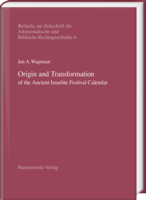|
|
more titles of the subject:
The book focusses on the origin and transformation of the priestly festival calendar. Since the epoch-making work of Julius Wellhausen at the end of the 19th century the differences between the various ancient Israelite festival calendars have often been explained in terms of a gradual evolution, which shows an increasing historicisation, denaturalisation and ritualisation. The festivals were in Wellhausen’s view gradually detached from agricultural conditions and celebrated more and more at fixed points in the year. This study tries to show that the changes in the priestly festival calendar reflect a conscious effort to adapt the ancient Israelite festival calendar to the semi-annual layout of the Babylonian festival year. The ramifications of the change only come to the fore after a careful study of the agricultural conditions of ancient Israel - and Mesopotamia - makes clear that passover and the festival of unleavened bread were originally celebrated in the second month of the year. The first month of the year envisaged by the priestly festival calendar for the celebration of passover and the festival of unleavened bread in turn mirrors the date of one of the two semi-annual Babylonian New Year festivals. The two Babylonian New Year festivals were celebrated exactly six months apart at the vernal and autumnal equinoxes. In order to adapt the ancient Israelite festival calendar to the Babylonian scheme with two New Year festivals a year, the date of passover and the festival of unleavened bread had to be moved up by one month. The consequences for the origin of passover, the festival of unleavened bread, the festival of weeks and the festival of huts are charted and the relations between the various ancient Israelite festival calendars are determined anew.
|






